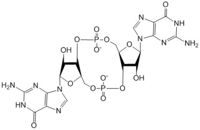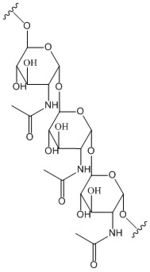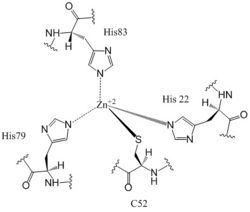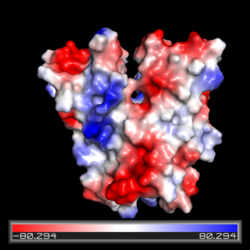Sandbox Reserved 1072
From Proteopedia
(Difference between revisions)
| Line 6: | Line 6: | ||
[[Image:C-di-GMP larger font.jpg |200 px|thumb|left|cyclic-dimeric-GMP]] | [[Image:C-di-GMP larger font.jpg |200 px|thumb|left|cyclic-dimeric-GMP]] | ||
[[Image:Poly B-1, 6 GlcNAc.jpg |150 px|left|thumb|poly-β-1,6-N-acetylglucosamine]] | [[Image:Poly B-1, 6 GlcNAc.jpg |150 px|left|thumb|poly-β-1,6-N-acetylglucosamine]] | ||
| - | Diguanylate cyclases are a group of class 2 transferase enzymes that catalyze the production of cyclic dimeric-guanosine monophosphate (c-di-GMP), an important <span class="plainlinks">[https://en.wikipedia.org/wiki/Second_messenger_system second messenger]</span> for <span class="plainlinks">[https://en.wikipedia.org/wiki/Signal_transduction signal transduction]</span>. Most commonly through phosphorylation or dephosphoylation events, signal transduction sends messages through cells to promote responses. <span class="plainlinks">[https://en.wikipedia.org/wiki/Escherichia_coli ''Escherechia coli'']</span>, a gram-negative bacterium often found in the intestines of mammals, uses diguanylate cyclase DgcZ in the synthesis of its <span class="plainlinks">[https://en.wikipedia.org/wiki/biofilm biofilm]</span>. Enzyme DgcZ from ''E. coli'' acts as a catalyst to synthesize cyclic di-GMP from two substrate guanosine triphosphate (GTP) molecules to aid in communication of signals throughout the bacteria. C-di-GMP is a second messenger in the production of poly-β-1,6-N-acetylglucosamine (poly-GlcNAc), a polysaccharide required for ''E. coli'' biofilm production. This biofilm allows ''E. coli'' to adhere to extracellular surfaces. The enzyme is only successfully crystallized in its inactive conformation. | + | Diguanylate cyclases are a group of class 2 transferase enzymes that catalyze the production of cyclic dimeric-guanosine monophosphate (c-di-GMP), an important <span class="plainlinks">[https://en.wikipedia.org/wiki/Second_messenger_system second messenger]</span> for <span class="plainlinks">[https://en.wikipedia.org/wiki/Signal_transduction signal transduction]</span>.<sup>[1]</sup> Most commonly through phosphorylation or dephosphoylation events, signal transduction sends messages through cells to promote responses. <span class="plainlinks">[https://en.wikipedia.org/wiki/Escherichia_coli ''Escherechia coli'']</span>, a gram-negative bacterium often found in the intestines of mammals, uses diguanylate cyclase DgcZ in the synthesis of its <span class="plainlinks">[https://en.wikipedia.org/wiki/biofilm biofilm]</span>.<sup>[2]</sup> Enzyme DgcZ from ''E. coli'' acts as a catalyst to synthesize cyclic di-GMP from two substrate guanosine triphosphate (GTP) molecules to aid in communication of signals throughout the bacteria. C-di-GMP is a second messenger in the production of poly-β-1,6-N-acetylglucosamine (poly-GlcNAc), a polysaccharide required for ''E. coli'' biofilm production. This biofilm allows ''E. coli'' to adhere to extracellular surfaces. The enzyme is only successfully crystallized in its inactive conformation. |
[[Image:DgcZ_Conformation_change_1.png|250 px|right|thumb|Diagram of DgcZ in its active (left) and inactive (right) conformations. Binding Zinc inactivates the enzyme.]] | [[Image:DgcZ_Conformation_change_1.png|250 px|right|thumb|Diagram of DgcZ in its active (left) and inactive (right) conformations. Binding Zinc inactivates the enzyme.]] | ||
| Line 47: | Line 47: | ||
== References == | == References == | ||
| - | Hengge, R. (2009). Principles of c-di-GMP signalling in bacteria. Nat. Rev. Microbiol. 7, 263–273. class="plainlinks">[https://www.nature.com/nrmicro/journal/v7/n4/full/nrmicro2109.html doi: doi:10.1038/nrmicro2109]</span> | + | 1. Hengge, R. (2009). Principles of c-di-GMP signalling in bacteria. Nat. Rev. Microbiol. 7, 263–273. class="plainlinks">[https://www.nature.com/nrmicro/journal/v7/n4/full/nrmicro2109.html doi: doi:10.1038/nrmicro2109]</span> |
2. Wang, X., Dubey, A.K., Suzuki, K., Baker, C.S., Babitzke, P., and Romeo, T. (2005). CsrA post-transcriptionally represses pgaABCD, responsible for synthesis of a biofilm polysaccharide adhesin of Escherichia coli. Mol. Microbiol. 56, 1648–1663. class="plainlinks">[http://onlinelibrary.wiley.com/doi/10.1111/j.1365-2958.2005.04648.x/abstract<span doi: 10.1111/j.1365-2958.2005.04648.x]</span> | 2. Wang, X., Dubey, A.K., Suzuki, K., Baker, C.S., Babitzke, P., and Romeo, T. (2005). CsrA post-transcriptionally represses pgaABCD, responsible for synthesis of a biofilm polysaccharide adhesin of Escherichia coli. Mol. Microbiol. 56, 1648–1663. class="plainlinks">[http://onlinelibrary.wiley.com/doi/10.1111/j.1365-2958.2005.04648.x/abstract<span doi: 10.1111/j.1365-2958.2005.04648.x]</span> | ||
Revision as of 03:35, 21 April 2017
| This Sandbox is Reserved from 02/09/2015, through 05/31/2016 for use in the course "CH462: Biochemistry 2" taught by Geoffrey C. Hoops at the Butler University. This reservation includes Sandbox Reserved 1051 through Sandbox Reserved 1080. |
To get started:
More help: Help:Editing |
Diguanylate Cyclase DgcZ from Escherichia coli
| |||||||||||






